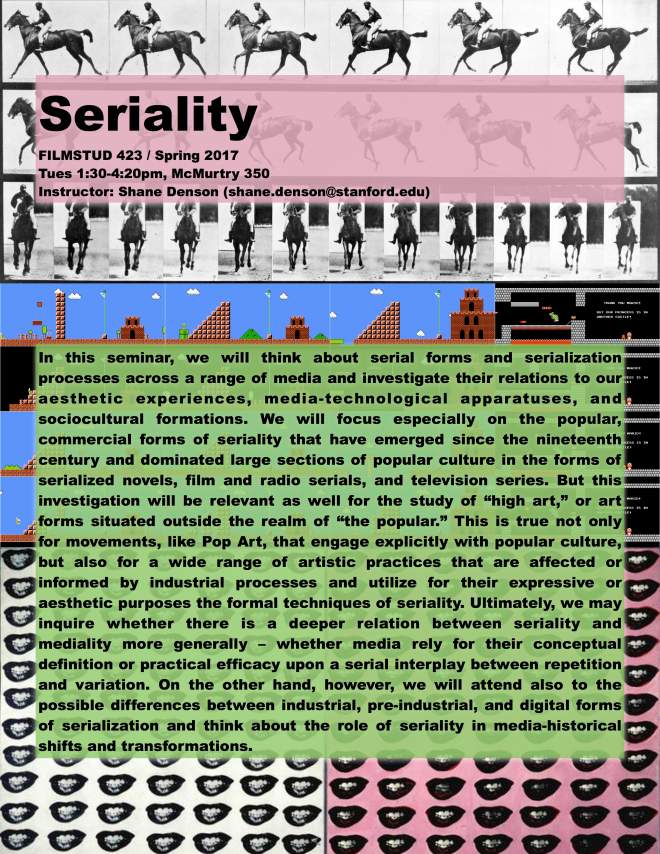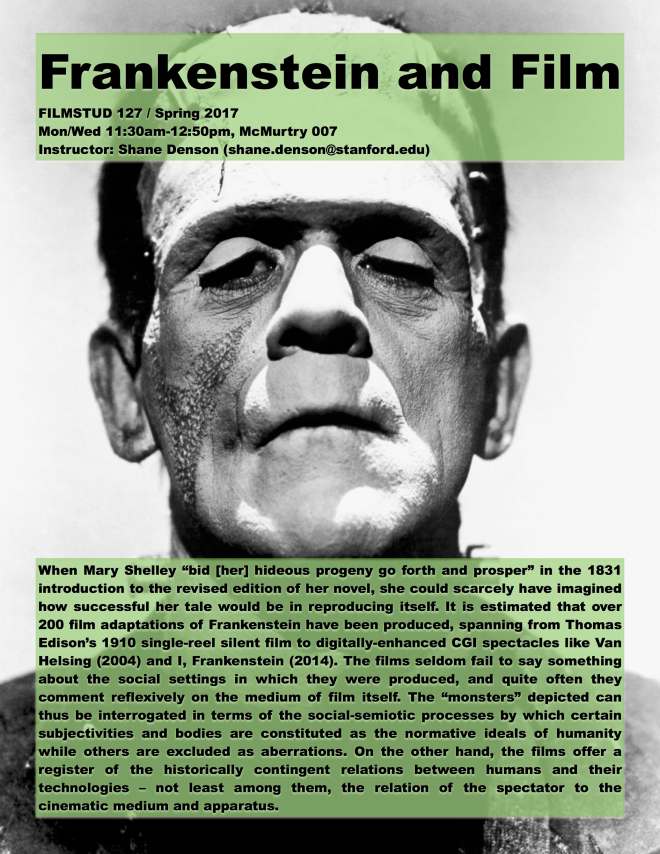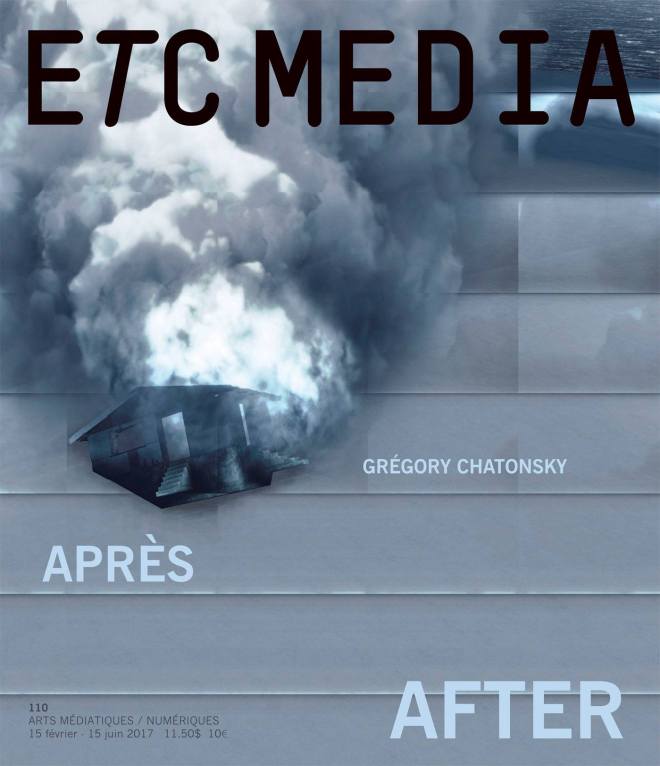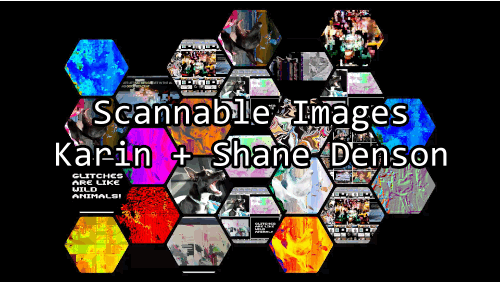
Flyer for my “Seriality” course, Spring 2017 at Stanford. Complete syllabus here.

Flyer for my “Seriality” course, Spring 2017 at Stanford. Complete syllabus here.

Flyer for my “Frankenstein and Film” class, Spring 2017 at Stanford. Complete syllabus here.

I am proud to have a piece on “Pre-Sponsive Gestures” and the work of French media artist Grégory Chatonsky included in the new issue of the Montreal-based ETC Media. Looks like a great issue, and happy to be in such good company!
CURRENT ISSUE // 110
GRÉGORY CHATONSKY: APRÈS LE RÉSEAU / AFTER THE NETWORKIssue 110 of ETC MEDIA is dedicated to Grégory Chatonsky, who has curated the form and content of this special issue. A Montreal resident for the last ten years, the artist is a pioneer of net art, founding Incident.net in 1994, and an unflagging explorer of the relationships between technology and anonymous existence. In this issue, the artist and a few other friends, artists, philosophers, art historians, and art critics reconsider the last two decades of experimentation, a time in which the world drastically changed through the widespread use of the Internet to reach a digital omnipresence that heralds a near extinction. Divided into 3 sections—“infinitude,” “hyperproduction,” “without ourselves”—ETC MEDIA becomes a platform for navigating in our era and gaining a better understanding of a future whose portents remain deeply ambivalent—promising and threatening all at once. Rather than being reduced to trendy notions often misunderstood by the contemporary art milieu, the concepts of post-digital, accelerationism, and speculative materialism constellate a world in the process of perishing and being born.
Collaborators
Grégory Chatonsky
Eve K. Tremblay
Pau Waelder
Bertrand Gervais and Arnaud Regnauld
Shane Denson
DeForrest Brown Jr.
Goliath Dyèvre
Pierre Cassou-Noguès
Erik Bordeleau
Nora N. Khan
Dylan Trigg
Pierre-Alexandre Fradet
Jussi Parikka
The conference program for the 2017 SCMS conference in Chicago is now available online (opens as PDF). As I mentioned recently, I will be participating in panel K3 (Friday, March 24, 2017, 9:00-10:45am) — a workshop dedicated to “Deformative Criticism and Digital Experimentations in Film & Media Studies.”

At the upcoming SCMS conference in Chicago, I will be participating in a workshop on “Deformative Criticism and Digital Experimentations in Film & Media Studies” (panel K3 on Friday, March 24, 2017 at 9:00am):
Deformative criticism has emerged as an innovative site of critical practice within media studies and digital humanities, revealing new insights into media texts by “breaking” them in controlled or chaotic ways. Deformative criticism includes a wide range of digital experiments that generate heretical and non-normative readings of media texts; because the results of these experiments are impossible to know in advance, they shift the boundaries of critical scholarship. Media scholars are particularly well situated to such experimentation, as many of our objects of study exist in digital forms that lend themselves to wide-ranging manipulation. Thus, deformative criticism offers a crucial venue for defining not only contemporary scholarly practice, but also media studies’ growing relationship to digital humanities.
Also participating in the workshop will be Jason Mittell (Middlebury College), Stephanie Boluk (UC Davis), Kevin L. Ferguson (Queens College, City University of New York), Mark Sample (Davidson College), and Virginia Kuhn (USC).
My own presentation/workshop contribution will focus on glitches and augmented reality as a deformative means of engaging with changing media-perceptual configurations, including the following case study:
Glitch, Augment, Scan
Scannable Images is a collaborative art/theory project by Karin + Shane Denson that interrogates post-cinema – its perceptual patterns, hyperinformatic simultaneities, and dispersals of attention – through an assemblage of static and animated images, databending and datamoshing techniques, and augmented reality (AR) video overlays. Viewed through the small screen of a smartphone or tablet – itself directed at a computer screen – only a small portion of the entire spectacle can be seen at once, thus reflecting and emulating the selective, scanning regard of post-cinematic images and confronting the viewer with the materiality of the post-cinematic media regime through the interplay of screens, pixels, people, and the physical and virtual spaces they occupy.
Syllabus for my grad seminar on Seriality (spring 2017).
Syllabus for “Frankenstein and Film” (Spring 2017).
Happy to be on the steering committee for Frankenstein@200 — a year-long series of events taking place at Stanford in 2018. I’ll be participating in a number of ways, including talks and several courses related to Frankenstein, among other things. I’ll post details here in due time. Also be sure to check out the project website, which is still under construction, but which is already chock full of announcements and constantly being updated.
The year 2018 marks the 200th anniversary of the publishing of Mary Shelley’s novel Frankenstein. The novel is eerily relevant today as we face ethical dilemmas around appropriate use of stem cells, questions about organ donation and organ harvesting, as well as animal to human transplants. Additionally, the rise of artificial intelligence portends an uncertain future of the boundaries between machines and humans. Frankenstein@200, will be a year-long series of academic courses and programs including a film festival, a play, a lecture series and an international Health Humanities Conference that will examine the numerous moral, scientific, sociological, ethical and spiritual dimensions of the work, and why Dr. Frankenstein and his monster still capture the moral imagination today. This project will be sponsored by the Stanford Medicine & the Muse Program in partnership with the Stanford Humanities Center, the Stanford Arts Institute, the Office of Religious Life, the Vice Provost for Teaching and Learning, Stanford Continuing Studies, the Cantor Arts Center, the Department of Art & Art History, and the Center for Biomedical Ethics.